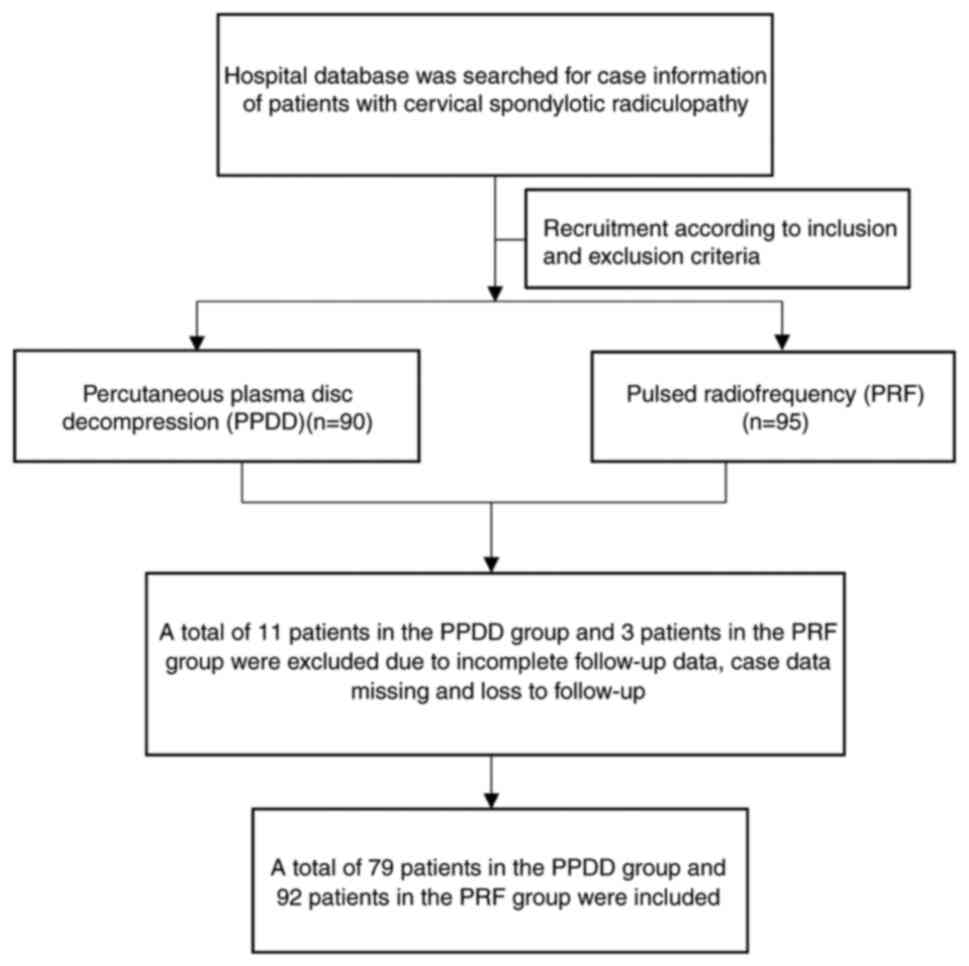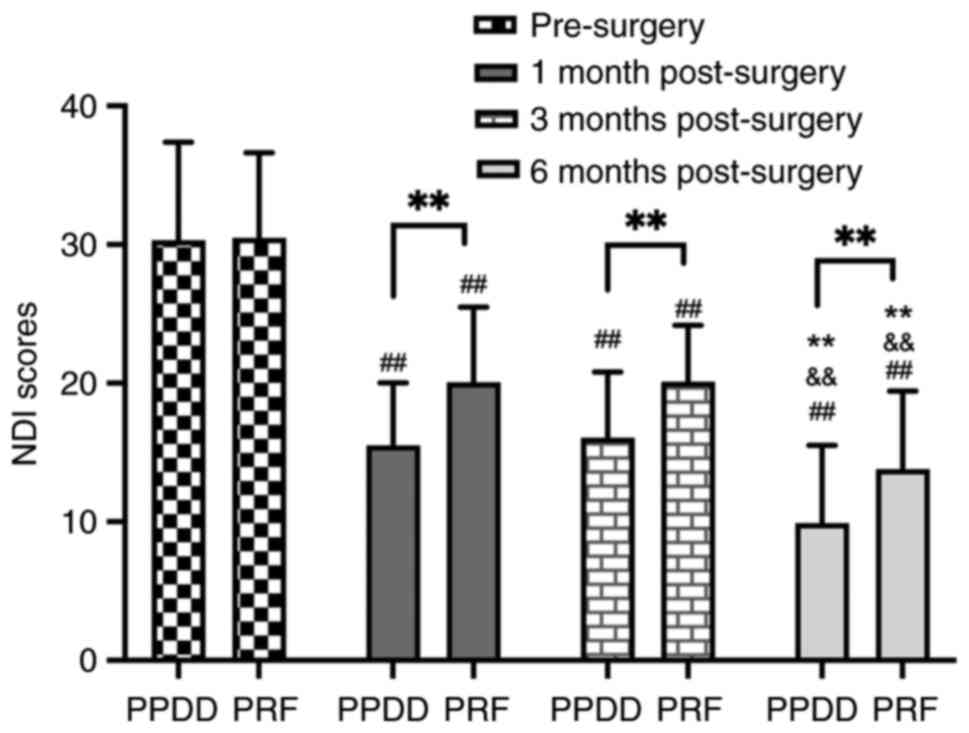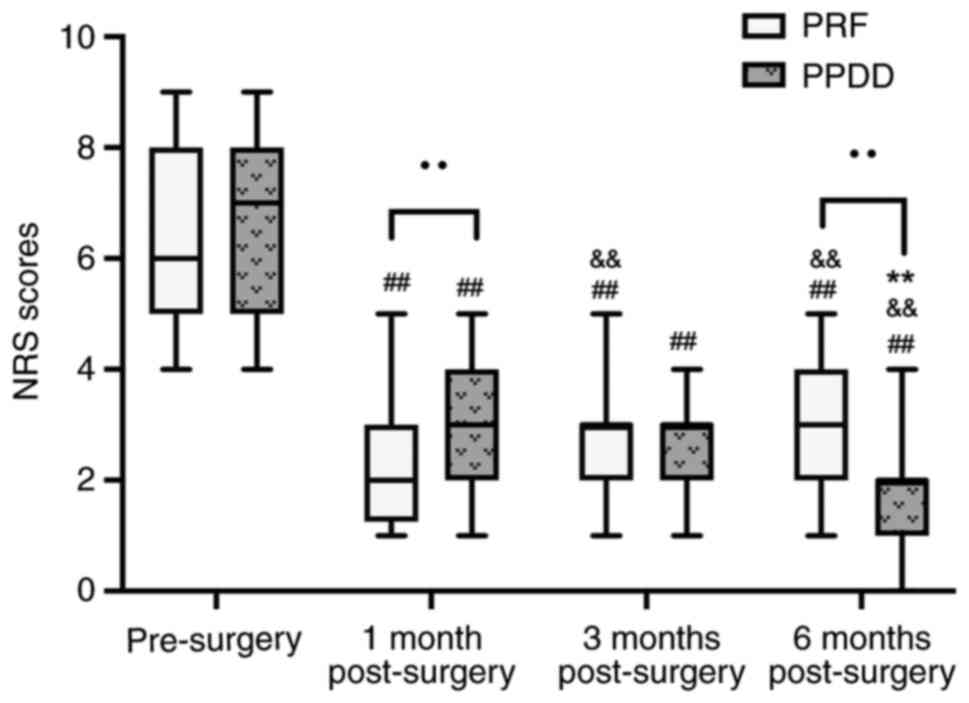|
1
|
Wang C, Gu Z, Yu J, Zhang P and Yang F:
Clinical observation of long chiropractic treatment on patients
with neurogenic cervical spondylosis: Study protocol for a
randomized controlled trial. Medicine (Baltimore).
101(e28861)2022.PubMed/NCBI View Article : Google Scholar
|
|
2
|
Wang P, Zuo G, Du SQ, Gao TC, Liu RJ, Hou
XZ, Ji X, Yin J, Li KM and Zhang Q: Meta-analysis of the
therapeutic effect of acupuncture and chiropractic on cervical
spondylosis radiculopathy: A systematic review and meta-analysis
protocol. Medicine (Baltimore). 99(e18851)2020.PubMed/NCBI View Article : Google Scholar
|
|
3
|
Ye LQ, Chen C, Liu YH, Li Z and Lu GL:
Effect of cervical spine motion on displacement of posterolateral
annulus fibrosus in cervical spondylotic radiculopathy with
contained posterolateral disc herniation: A three-dimensional
finite element analysis. J Orthop Surg Res. 17(548)2022.PubMed/NCBI View Article : Google Scholar
|
|
4
|
Thind H, Ramanathan D, Ebinu J, Copenhaver
D and Kim KD: Headache relief is maintained 7 years after anterior
cervical spine surgery: Post hoc analysis from a multicenter
randomized clinical trial and cervicogenic headache hypothesis.
Neurospine. 17:365–373. 2020.PubMed/NCBI View Article : Google Scholar
|
|
5
|
Sun Y, Muheremu A, Yan K, Yu J, Zheng S
and Tian W: Effect of different surgical methods on headache
associated with cervical spondylotic myelopathy and/or
radiculopathy. BMC Surg. 15(105)2015.PubMed/NCBI View Article : Google Scholar
|
|
6
|
Pang X, Liu C and Peng B: Anterior
cervical surgery for the treatment of cervicogenic headache caused
by cervical spondylosis. J Pain Res. 13:2783–2789. 2020.PubMed/NCBI View Article : Google Scholar
|
|
7
|
Antonaci F, Bono G and Chimento P:
Diagnosing cervicogenic headache. J Headache Pain. 7:145–148.
2006.PubMed/NCBI View Article : Google Scholar
|
|
8
|
Chua NHL, Suijlekom HV, Wilder-Smith OH
and Vissers KC: Understanding cervicogenic headache. Anesth Pain
Med. 2:3–4. 2012.PubMed/NCBI View Article : Google Scholar
|
|
9
|
Goyal S, Kumar A, Mishra P and Goyal D:
Efficacy of interventional treatment strategies for managing
patients with cervicogenic headache: A systematic review. Korean J
Anesthesiol. 75:12–24. 2022.PubMed/NCBI View Article : Google Scholar
|
|
10
|
Chen C, Yuchi CX, Gao Z, Ma X, Zhao D, Li
JW, Xu B, Zhang CQ, Wang Z, Du CF and Yang Q: Comparative analysis
of the biomechanics of the adjacent segments after minimally
invasive cervical surgeries versus anterior cervical discectomy and
fusion: A finite element study. J Orthop Translat. 23:107–112.
2020.PubMed/NCBI View Article : Google Scholar
|
|
11
|
Alix ME and Bates DK: A proposed etiology
of cervicogenic headache: The neurophysiologic basis and anatomic
relationship between the dura mater and the rectus posterior
capitis minor muscle. J Manipulative Physiol Ther. 22:534–539.
1999.PubMed/NCBI View Article : Google Scholar
|
|
12
|
van Suijlekom H, Van Zundert J, Narouze S,
van Kleef M and Mekhail N: 6. Cervicogenic headache. Pain Pract.
10:124–130. 2010.PubMed/NCBI View Article : Google Scholar
|
|
13
|
Shimohata K, Hasegawa K, Onodera O,
Nishizawa M and Shimohata T: The clinical features, risk factors,
and surgical treatment of cervicogenic headache in patients with
cervical spine disorders requiring surgery. Headache. 57:1109–1117.
2017.PubMed/NCBI View Article : Google Scholar
|
|
14
|
Diener HC, Kaminski M, Stappert G, Stolke
D and Schoch B: Lower cervical disc prolapse may cause cervicogenic
headache: Prospective study in patients undergoing surgery.
Cephalalgia. 27:1050–1054. 2007.PubMed/NCBI View Article : Google Scholar
|
|
15
|
Yang L, Li Y, Dai C, Pang X, Li D, Wu Y,
Chen X and Peng B: Anterior cervical decompression and fusion
surgery for cervicogenic headache: A multicenter prospective cohort
study. Front Neurol. 13(1064976)2022.PubMed/NCBI View Article : Google Scholar
|
|
16
|
Radhakrishnan K, Kitchy WJ, O'Fallon M and
Kurland LT: Epidemiology of cervical radiculopathy. A
population-based study from Rochester, Minnesota, 1976 through
1990. Brain. 117:325–335. 1994.PubMed/NCBI View Article : Google Scholar
|
|
17
|
Luyao H, Xiaoxiao Y, Tianxiao F, Yuandong
L and Wang P: Management of cervical spondylotic radiculopathy: A
systematic review. Global Spine J. 12:1912–1924. 2022.PubMed/NCBI View Article : Google Scholar
|
|
18
|
Jeon HC, Kim CS, Kim SC, Kim TH, Jang JW,
Choi KY, Moon BJ and Lee JK: Posterior cervical microscopic
foraminotomy and discectomy with laser for unilateral
radiculopathy. Chonnam Med J. 51:129–134. 2015.PubMed/NCBI View Article : Google Scholar
|
|
19
|
Birnbaum K: Percutaneous cervical disc
decompression. Surg Radiol Anat. 31:379–387. 2009.PubMed/NCBI View Article : Google Scholar
|
|
20
|
Kwak SG, Lee DG and Chang MC:
Effectiveness of pulsed radiofrequency treatment on cervical
radicular pain: A meta-analysis. Medicine (Baltimore).
97(e11761)2018.PubMed/NCBI View Article : Google Scholar
|
|
21
|
Bonaldi G, Baruzzi F, Facchinetti A,
Fachinetti P and Lunghi S: Plasma radio-frequency-based diskectomy
for treatment of cervical herniated nucleus pulposus: Feasibility,
safety, and preliminary clinical results. AJNR Am J Neuroradiol.
27:2104–2111. 2006.PubMed/NCBI
|
|
22
|
Snidvongs S and Mehta V: Pulsed radio
frequency: A non-neurodestructive therapy in pain management. Curr
Opin Support Palliat Care. 4:107–110. 2010.PubMed/NCBI View Article : Google Scholar
|
|
23
|
Sam J, Catapano M, Sahni S, Ma F,
Abd-Elsayed A and Visnjevac O: Pulsed radiofrequency in
interventional pain management: Cellular and molecular mechanisms
of action-an update and review. Pain Physician. 24:525–532.
2021.PubMed/NCBI
|
|
24
|
Kasch R, Mensel B, Schmidt F, Ruetten S,
Barz T, Froehlich S, Seipel R, Merk HR and Kayser R: Disc volume
reduction with percutaneous nucleoplasty in an animal model. PLoS
One. 7(e50211)2012.PubMed/NCBI View Article : Google Scholar
|
|
25
|
Sjaastad O, Fredriksen TA and Pfaffenrath
V: Cervicogenic headache: Diagnostic criteria. The cervicogenic
headache international study group. Headache. 38:442–445.
1998.PubMed/NCBI View Article : Google Scholar
|
|
26
|
Blumenfeld A and Siavoshi S: The
challenges of cervicogenic headache. Curr Pain Headache Rep.
22(47)2018.PubMed/NCBI View Article : Google Scholar
|
|
27
|
Alo KM, Yland MJ, Redko V, Feler C and
Naumann C: Lumbar and sacral nerve root stimulation (NRS) in the
treatment of chronic pain: A novel anatomic approach and neuro
stimulation technique. Neuromodulation. 2:23–31. 1999.PubMed/NCBI View Article : Google Scholar
|
|
28
|
Reisener MJ, Okano I, Zhu J, Salzmann SN,
Miller CO, Shue J, Sama AA, Cammisa FP, Girardi FP and Hughes AP:
Workers' compensation status in association with a high NDI score
negatively impacts post-operative dysphagia and dysphonia following
anterior cervical fusion. World Neurosurg. 154:e39–e45.
2021.PubMed/NCBI View Article : Google Scholar
|
|
29
|
Bogduk N: The anatomical basis for
cervicogenic headache. J Manipulative Physiol Ther. 15:67–70.
1992.PubMed/NCBI
|
|
30
|
Das B, Conroy M, Moore D, Lysaght J and
McCrory C: Human dorsal root ganglion pulsed radiofrequency
treatment modulates cerebrospinal fluid lymphocytes and
neuroinflammatory markers in chronic radicular pain. Brain Behav
Immun. 70:157–165. 2018.PubMed/NCBI View Article : Google Scholar
|
|
31
|
Cho HK, Kang JH, Kim SY, Choi MJ, Hwang
SJ, Cho YW and Ahn SH: Changes in neuroglial activity in multiple
spinal segments after caudal epidural pulsed radiofrequency in a
rat model of lumbar disc herniation. Pain Physician.
19:E1197–E1209. 2016.PubMed/NCBI
|
|
32
|
Hack GD, Koritzer RT, Robinson WL,
Hallgren RC and Greenman PE: Anatomic relation between the rectus
capitis posterior minor muscle and the dura mater. Spine (Phila Pa
1976). 20:2484–2486. 1995.PubMed/NCBI View Article : Google Scholar
|
|
33
|
Lee DG, Ahn SH and Lee J: Comparative
effectivenesses of pulsed radiofrequency and transforaminal steroid
injection for radicular pain due to disc herniation: A prospective
randomized trial. J Korean Med Sci. 31:1324–1330. 2016.PubMed/NCBI View Article : Google Scholar
|
|
34
|
Song XJ, Hu SJ, Greenquist KW, Zhang JM
and LaMotte RH: Mechanical and thermal hyperalgesia and ectopic
neuronal discharge after chronic compression of dorsal root
ganglia. J Neurophysiol. 82:3347–3358. 1999.PubMed/NCBI View Article : Google Scholar
|
|
35
|
Gerges FJ, Lipsitz SR and Nedeljkovic SS:
A systematic review on the effectiveness of the nucleoplasty
procedure for discogenic pain. Pain Physician. 13:117–132.
2010.PubMed/NCBI
|
|
36
|
Lee JH and Lee SH: Comparison of clinical
efficacy between interlaminar and transforaminal epidural injection
in patients with axial pain due to cervical disc herniation.
Medicine (Baltimore). 95(e2568)2016.PubMed/NCBI View Article : Google Scholar
|
|
37
|
Tang ZY, Shu B, Cui XJ, Zhou CJ, Shi Q,
Holz J and Wang YJ: Changes of cervical dorsal root ganglia induced
by compression injury and decompression procedure: A novel rat
model of cervical radiculoneuropathy. J Neurotrauma. 26:289–295.
2009.PubMed/NCBI View Article : Google Scholar
|
|
38
|
Ren D, Zhang Z, Sun T and Li F: Effect of
percutaneous nucleoplasty with coblation on phospholipase A2
activity in the intervertebral disks of an animal model of
intervertebral disk degeneration: A randomized controlled trial. J
Orthop Surg Res. 10(38)2015.PubMed/NCBI View Article : Google Scholar
|
|
39
|
Wu C and Sun D: GABA receptors in brain
development, function, and injury. Metab Brain Dis. 30:367–379.
2015.PubMed/NCBI View Article : Google Scholar
|
|
40
|
Tsantoulas C and McMahon SB: Opening paths
to novel analgesics: The role of potassium channels in chronic
pain. Trends Neurosci. 37:146–158. 2014.PubMed/NCBI View Article : Google Scholar
|












